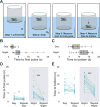The Jellyfish Cassiopea Exhibits a Sleep-like State
- PMID: 28943083
- PMCID: PMC5653286
- DOI: 10.1016/j.cub.2017.08.014
The Jellyfish Cassiopea Exhibits a Sleep-like State
Abstract
Do all animals sleep? Sleep has been observed in many vertebrates, and there is a growing body of evidence for sleep-like states in arthropods and nematodes [1-5]. Here we show that sleep is also present in Cnidaria [6-8], an earlier-branching metazoan lineage. Cnidaria and Ctenophora are the first metazoan phyla to evolve tissue-level organization and differentiated cell types, such as neurons and muscle [9-15]. In Cnidaria, neurons are organized into a non-centralized radially symmetric nerve net [11, 13, 15-17] that nevertheless shares fundamental properties with the vertebrate nervous system: action potentials, synaptic transmission, neuropeptides, and neurotransmitters [15-20]. It was reported that cnidarian soft corals [21] and box jellyfish [22, 23] exhibit periods of quiescence, a pre-requisite for sleep-like states, prompting us to ask whether sleep is present in Cnidaria. Within Cnidaria, the upside-down jellyfish Cassiopea spp. displays a quantifiable pulsing behavior, allowing us to perform long-term behavioral tracking. Monitoring of Cassiopea pulsing activity for consecutive days and nights revealed behavioral quiescence at night that is rapidly reversible, as well as a delayed response to stimulation in the quiescent state. When deprived of nighttime quiescence, Cassiopea exhibited decreased activity and reduced responsiveness to a sensory stimulus during the subsequent day, consistent with homeostatic regulation of the quiescent state. Together, these results indicate that Cassiopea has a sleep-like state, supporting the hypothesis that sleep arose early in the metazoan lineage, prior to the emergence of a centralized nervous system.
Keywords: Cassiopea; Cnidaria; evolution of sleep; jellyfish; sleep.
Copyright © 2017 Elsevier Ltd. All rights reserved.
Figures




Comment in
-
Sleep Origins: Restful Jellyfish Are Sleeping Jellyfish.Curr Biol. 2017 Oct 9;27(19):R1060-R1062. doi: 10.1016/j.cub.2017.08.024. Curr Biol. 2017. PMID: 29017039
References
-
- Hendricks JC, Finn SM, Panckeri KA, Chavkin J, Williams JA, Sehgal A, Pack AI. Rest in Drosophila is a sleep-like state. Neuron. 2000;25:129–138. - PubMed
-
- Shaw PJ, Cirelli C, Greenspan RJ, Tononi G. Correlates of sleep and waking in Drosophila melanogaster. Science. 2000;287:1834–1837. - PubMed
-
- Raizen DM, Zimmerman JE, Maycock MH, Ta UD, You YJ, Sundaram MV, Pack AI. Lethargus is a Caenorhabditis elegans sleep-like state. Nature. 2008;451:569–572. - PubMed
MeSH terms
Grants and funding
LinkOut - more resources
Full Text Sources
Other Literature Sources
Miscellaneous

